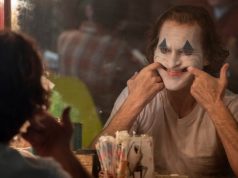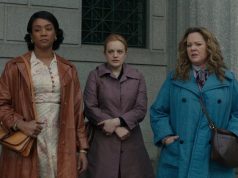Every movie needs to stand on its own two feet, and you could argue that there’s no reason to compare a remake to the original if the original is old, obscure, or otherwise unlikely to have been seen by your audience. But “Spider-Man” came out ten years ago, and the second of its two sequels is only five years behind us. The Sam Raimi-directed trilogy made a total of $2.5 billion worldwide.
So I’m not even going to try to avoid comparing Marc Webb’s new “The Amazing Spider-Man” to its predecessors. Such an effort would be futile and pointless. Everyone in the audience will be comparing them; why shouldn’t critics?
Though not exactly a “remake” of the 2002 “Spider-Man,” this is a retelling of Spidey’s origin story: we’re back at square one, with bites from radioactive spiders, homemade costumes, and the death of Uncle Ben. This time Peter is a mechanically inclined high school loser — played with effective wimpy vulnerability by Andrew Garfield — whose parents (Campbell Scott and Embeth Davidtz) hurriedly left him with his Uncle Ben (Martin Sheen) and Aunt May (Sally Field) some years ago, never to return. Dad was a scientist working in the field of inter-species genetics with the eminent Dr. Curt Connors (Rhys Ifans), an erudite but disheveled one-armed genius who dreams of harnessing various organisms’ powers to create a “world without weakness.”
Peter comes into contact with his father’s old collaborator through Gwen Stacy (Emma Stone), a fellow student at Midtown Science High School who interns for Connors. A tour of the high-tech science division of the corporation Connors works for provides a certain arachnid the opportunity to bite a certain young man, who subsequently develops certain powers, et cetera. Where the Raimi version, with the dorkier Tobey Maguire in the lead, emphasized Peter’s awestruck jubilation at discovering his new strength and abilities, the Webb version (no pun intended) focuses on Peter’s alarm, and on his initial inability to control what has happened to him. That sense of panic over what one might have unleashed through one’s scientific meddling arises again when Dr. Connors experiments on himself and experiences unforeseen physical changes, rendering him the movie’s official villain.
As the newly minted Spider-Man, Peter’s interest in crime-fighting extends only as far as finding the fleeing robber who killed Uncle Ben. These efforts are considered dangerous vigilantism by New York’s no-nonsense police captain (Denis Leary), but hey, at least he’s getting criminals off the street. It is later, after a harrowing experience helping civilians, that Spidey realizes he has a duty to use his powers for more than selfish reasons. His scene with a little boy on a bridge is an almost perfect encapsulation of why we like superheroes: it’s personal, it’s quietly heroic, and it inspires awe in a child.
Peter and Gwen are the core of the movie. If you don’t care for them, I don’t know if you’d care for any of it. As luck would have it, Garfield and Stone have a sweet chemistry together, her sparky personality balancing his softer one. (Peter becomes a smart-aleck when he puts the Spider-Man mask on, but the attitude never seems to suit him, possibly because his bon mots aren’t funny.) Their relationship is a heightened mix of authenticity and big-screen romanticism — no surprise to those of us who were fans of the director’s previous film, “500 Days of Summer,” in which he achieved a similar effect with two similar actors.
“Spider-Man” (2002) A-
“Spider-Man 2” (2004) A
“Spider-Man 3” (2007) B-
“The Amazing Spider-Man” (2012) C+
“The Amazing Spider-Man 2” (2014) C
“Spider-Man: Homecoming” (2017) B+
Webb doesn’t show nearly as much facility for the action sequences, most of which can be described as somewhere between “fine” and “good enough.” Maybe we’ve been overloaded with too many of these scenes — not just in the Spider-Man movies but in all the comic book adventures of the last decade — but none of the action here is memorable. It feels like an average issue of a comic book.
Which is kind of what it is. As the fourth Spider-Man movie in ten years, its effort to justify its existence is more arduous than most films’, and to approach it as an “event” movie is to set yourself up for disappointment. The screenplay — credited to James Vanderbilt (“Zodiac”), Alvin Sargent (“Spider-Man 2”), and Harry Potter adapter Steve Kloves — while generally nimble, falls into embarrassing corniness at times, including a cringe-worthy sequence involving construction cranes that’s accompanied by on-the-nose TV news commentary: “Spider-Man appears to be injured. It’s not clear if he’s going to make it!”
Still, that’s better than the scene where Peter first enters Connors’ facility with a group of students and, looking for his name tag, is told by the receptionist, “You’ll find yourself to the left.” In case that didn’t drive the point home, she repeats the metaphor: “Are you having trouble finding yourself?” Ugh.
But the story’s all right, the performances are decent, the special effects are top-notch. In some respects, the only thing that keeps this from being an outstanding Spider-Man origin film is that it isn’t the first one. In a parallel universe, where “The Amazing Spider-Man” came out in 2002 and the Tobey Maguire “Spider-Man” is the 2012 reboot, the unfavorable comparisons run in the opposite direction. (Or so I assume. I am not in contact with a parallel universe.) I think a viewer who hasn’t seen any of the other Spidey movies, who is disposed to enjoying this sort of thing at all, would find this one perfectly serviceable. The problem is that few such people exist. “The Amazing Spider-Man” is fine; there just isn’t any reason for it.
C+ (2 hrs., 16 min.; )





